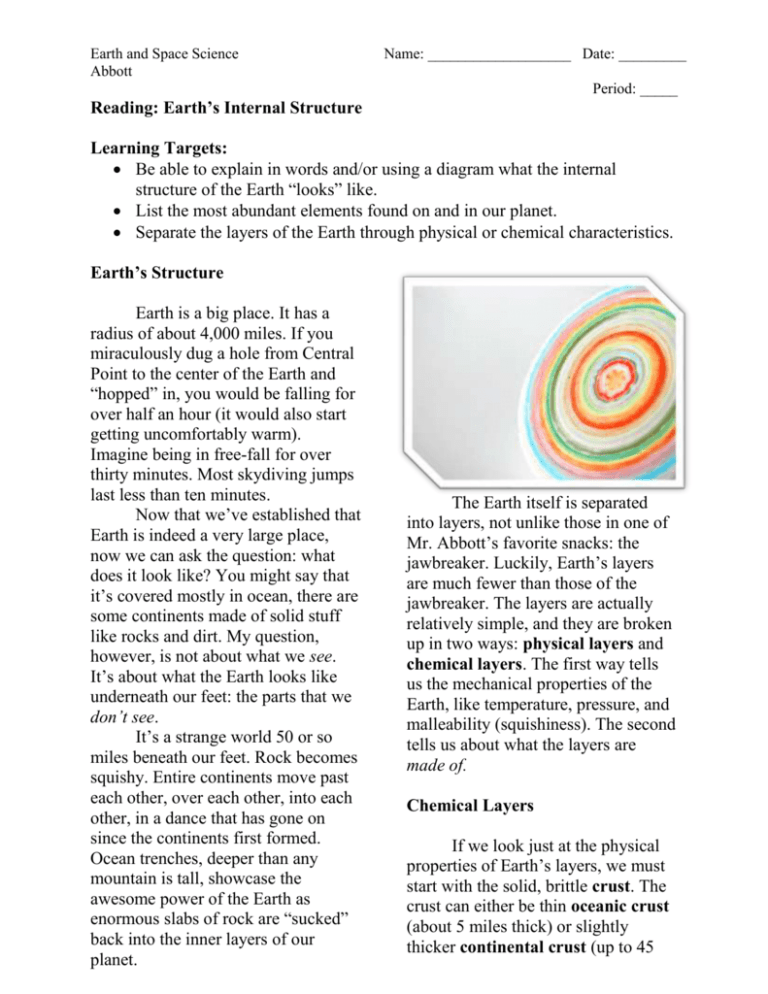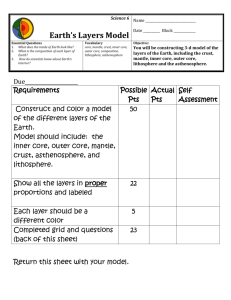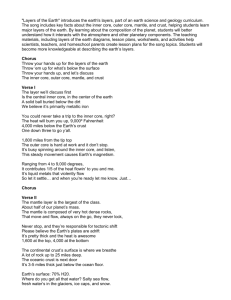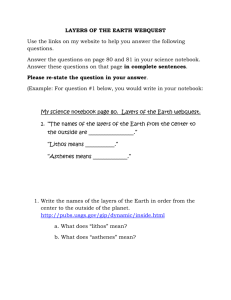
Earth and Space Science
Abbott
Name: ___________________ Date: _________
Period: _____
Reading: Earth’s Internal Structure
Learning Targets:
Be able to explain in words and/or using a diagram what the internal
structure of the Earth “looks” like.
List the most abundant elements found on and in our planet.
Separate the layers of the Earth through physical or chemical characteristics.
Earth’s Structure
Earth is a big place. It has a
radius of about 4,000 miles. If you
miraculously dug a hole from Central
Point to the center of the Earth and
“hopped” in, you would be falling for
over half an hour (it would also start
getting uncomfortably warm).
Imagine being in free-fall for over
thirty minutes. Most skydiving jumps
last less than ten minutes.
Now that we’ve established that
Earth is indeed a very large place,
now we can ask the question: what
does it look like? You might say that
it’s covered mostly in ocean, there are
some continents made of solid stuff
like rocks and dirt. My question,
however, is not about what we see.
It’s about what the Earth looks like
underneath our feet: the parts that we
don’t see.
It’s a strange world 50 or so
miles beneath our feet. Rock becomes
squishy. Entire continents move past
each other, over each other, into each
other, in a dance that has gone on
since the continents first formed.
Ocean trenches, deeper than any
mountain is tall, showcase the
awesome power of the Earth as
enormous slabs of rock are “sucked”
back into the inner layers of our
planet.
The Earth itself is separated
into layers, not unlike those in one of
Mr. Abbott’s favorite snacks: the
jawbreaker. Luckily, Earth’s layers
are much fewer than those of the
jawbreaker. The layers are actually
relatively simple, and they are broken
up in two ways: physical layers and
chemical layers. The first way tells
us the mechanical properties of the
Earth, like temperature, pressure, and
malleability (squishiness). The second
tells us about what the layers are
made of.
Chemical Layers
If we look just at the physical
properties of Earth’s layers, we must
start with the solid, brittle crust. The
crust can either be thin oceanic crust
(about 5 miles thick) or slightly
thicker continental crust (up to 45
Earth and Space Science
Abbott
Name: ___________________ Date: _________
Period: _____
miles thick). Compared to the
radius of the Earth, this would
be the candy shell of a peanut
butter M&M. The crust, while
very brittle and solid, is a very
small layer!
The oceanic crust is
made up mostly of a rock
called basalt, which is created
when magma cools and
solidifies. However, the thicker
continental crust is made up of
a variety of rocks (many of
which Mr. Abbott will have on
display during most of the
unit).
Going deeper, we have
the mantle. This layer is very
thick (about 1,750 miles), and
in fact makes up most of the
volume of the Earth. The
mantle contains more metals
such as iron, aluminum,
magnesium, etc. It also
contains an abundance of silicon and
oxygen.
The last chemical layer is
known as the core. This layer is rich
in iron and nickel. The movement of
these magnetic elements is thought to
generate Earth’s magnetic field
(thereby making compasses possible).
The core, being a sphere unlike the
“shells” surrounding it, has a radius of
about 2,154 miles.
Physical Layers
If the chemical layers tell us
what stuff the Earth is made out of,
the physical layers tell us things like
how hot, how much pressure, and how
solid. The physical layers are a bit
more complicated, because the
relationships between pressure and
temperature are complicated.
When we look at the physical
layers of the Earth, we actually add a
couple. The mantle is broken up into
an upper mantle and a lower mantle,
and the core is broken into an outer
core and an inner core.
Earth and Space Science
Abbott
Name: ___________________ Date: _________
Period: _____
Because the most “shallow”
part of the upper mantle is still really
solid, we actually lump it in with the
crust and call it by its own name: the
lithosphere. Thus, the lithosphere
contains the crust and the part of the
upper mantle that are very hard and
brittle. The thickness of the
lithosphere, taken as a whole, is about
62 miles.
The rest of the upper mantle is
much hotter. As we have already
learned, higher temperatures mean
that the molecules in matter are more
“spread out” and tend to be more
“mobile”. This hotter part of the upper
mantle, called the asthenosphere, is
still solid, but can be molded (think of
old clay). The asthenosphere is
around 192 miles thick.
This may seem unimportant,
but the “softness” of the
asthenosphere actually means that the
lithosphere is detached from the upper
mantle. It can actually slide around
and move about on top of the softer
layer of Earth. Because of the high
temperatures, the soft rock can also
“flow”.
As we keep going down, both
the temperature and pressure increase
a lot. They increase so much that rock
and metal MELT. This is the realm of
the outer core, which is around 1,400
miles thick. Temperatures here can
get as high as 11,000 degrees
Fahrenheit. That’s kind of hot. The
pressure can be around a million
atmospheres (ever feel the pressure as
you swim to the bottom of a pool?
Imagine that about 500,000 times
worse).
It’s this region that tends to
send plumes of molten rock and metal
to the surface of the Earth, which
causes all kinds of crazy stuff to
happen that we won’t get into right
now. Finally, the pressures of the
inner core of our planet are so
incredibly high that they force the
molten rock and metal to become
solid again. We’re left with a very
dense, very hot ball of iron and nickel
with a radius of about 760 miles.
What’s it all made of?
It’s all well and good to talk about the
layers of the Earth. They’re important.
But what are they made of? What
elements from the periodic table show
up the most on planet Earth? The
answer might surprise you.
We know that the Earth’s
surface has a large amount of water
(H2O) and various gases in the
atmosphere. However, we’re not
interested in the surface yet. We want
to know what exists in the solid Earth,
terra firma.
In fact, the most abundant
element in our crust is oxygen.
However, the majority of it isn’t what
we breathe in: it’s mixed in with other
elements in the solid Earth itself. It’s
been calculated (by people much
smarter than Mr. Abbott) that oxygen
Earth and Space Science
Abbott
Name: ___________________ Date: _________
Period: _____
makes up some 47% of the Earth’s
elements.
What’s next? Maybe hydrogen
or nitrogen? No! In fact, the second
most abundant element is silicon
(about 28%). Silicon and oxygen form
very strong covalent bonds
(remember those?. The chemical
formula that usually results from this
is SiO4. Chemists have a very fancy
word for this: the silicon-oxygen
tetrahedron. It is these molecules
that make up the vast majority of the
minerals on our planet.
The next most abundant
element is aluminum (8%), and then
iron (5%). Other metals, such as
potassium, calcium, sodium, and
magnesium exist in relatively small
amounts. We also know from our
study of radioactive decay that there
are small amounts of heavier elements
(uranium, polonium, lead, etc.).
We need to be careful when we
think about this whole idea of
abundance. It may seem like there’s
not much iron in the solid Earth, but
keep in mind: the Earth has a mass of
about 6 million million million
million kilograms. Five percent of six
million million million million
kilograms is about three million
million million hundred thousand
kilograms.
That’s a lot of iron.
Sources:
My brain
Tarbuck, Lutgens, and Tasa. Earth
Science. Upper Saddle River:
Pearson Prentice-Hall, 2009.
Print.






